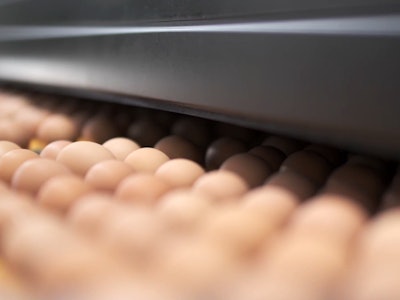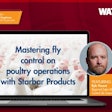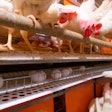
In this WATT Poultry Chat, Jeroen Bielleman, product manager, grading solutions, with MOBA, examines how the latest technology is driving growth in the egg industry, addressing a number of issues that the sector currently faces.
Mark Clements: Hello, and welcome to WATT Poultry Chat. I'm your host Mark Clements, editor-in-chief, poultry, with WATT Global Media, and today's Poultry Chat is brought to you by MOBA.
MOBA is the recognized leading total solutions provider for the egg industry. MOBA offers highly innovative solutions that meet the high standards of today's market.
Today, we're talking to Jeroen Bielleman, product manager, grading solutions, with MOBA, about how technology is driving the egg industry. Welcome Jeroen. Thank you for joining us today.
Jeroen Bielleman: Thank you, Mark.
MC: Could you tell us a little bit about your vision for the egg industry?
JB: Yes, of course, Mark. Thanks for having me.
If you look at the future of egg grading, I think we should take a few key aspects into consideration, and I will mention the main four elements to keep in mind.
I will start with the shortage of labor. We see it's a worldwide trend that companies are limited in finding labor, labor in general, but also skilled labor. So that's the first trend.
The second thing is the value of the eggs. We see a lot of cost increases, let's say, due to inflation, but also due to higher feed prices. That comes from factors like the war in Ukraine, for instance, that's driving up costs, so customers are focusing on the value per egg.
A third thing is food safety. Food safety is getting way more in the front of the industry. And you want to prevent cross contamination from egg to egg and prevent, let's say, bacteria like Salmonella to infect your eggs. And on the other end, it drives the, let's say, the cleaning restrictions for our equipment.
And the last one is efficiency and, let's say, connectivity of machines. And you want to have, on one hand, you want to have a most efficient operation, a worry-free operation, and you want to have also tracking and tracing to secure the origin of your eggs.
So I think those four aspects play an important role in continuing the industry to grow, and it's mainly driven by automation and technology. And technology is something that is mainly in all the detection systems because detection systems will play a very important role in our equipment. And it will reduce the need for manual labor and will also improve food safety and with use of latest technology, like vision and machine learning. And I think integration and advanced software functionalities and software solutions will provide valuable insights in improving, let's say, production efficiency and egg quality.
MC: You recently introduced a new egg grading machine, the Omnia PX+. How does that contribute to the vision that you've just described for us?
JB: Correct, correct. We introduced the PX+, and you can see it as a next generation grading machine, and it has the latest vision technology on board. And I think it's an absolute game changer in the industry, because using the vision technology, it's combined with, let's say, artificial intelligence and machine learning, we can detect all kinds of characteristics of the egg.
And you must think of defects of the outside of the egg, let's say if any dirt is on the egg, if an egg is leaking or not. We can also detect the correct level of an egg, if you have visual cracks but you also have little, tiny hairline cracks that will influence, of course, the quality of the eggs, and we can also determine the weight of the eggs. And this is partly done by two detection systems. We call them the egg inspector and vision shell inspector. And with those three systems I think we contribute to three of the before mentioned aspects and it is because the detection is fully based on vision, by cameras and lighting, there's no more need for maintenance and cleaning so much because the there are no, let's say, complex or sensitive mechanics anymore in the in the systems, it's only cameras, and all the detection is done by taking images of your eggs.
And also, the operation is improved because we have introduced an EggQualizer where you can set sensitivity for individual defects on your on your computer screen. So that's one thing. So it reduces the need for skilled labor. And, and we created a very consistent detection system which reaches a higher detection rate and, therefore, you will, let's say you have minimal, or less, false rejects, and that will lead to a higher yield and more Grade A eggs.
And the last thing that I think we contribute is, there is no need to physically touch the eggs. If you have a traditional weighing system, you need, somehow, to touch the eggs or to have them weighed or inspected. And there's then a risk of cross contamination and since the need, because of this vision and camera technology does not touch the egg, the risk of cross contamination will be reduced to an absolute minimum. And, therefore, also because of no egg touching elements anymore, the machines will be easier to clean and to operate.
MC: So let's say if I were an egg producer, and I would like to see the PX+ in operation, is there somewhere that I can go to see the machine in real life?
JB: Yes, you can, you can certainly. Of course, in real life operation it’s inside a customer location, so that's pretty hard to visit. We have one operational machine currently in the U.S, since October this year, and it's running, its grading eggs according to the USDA standards. So that's on a physical location.
And of course, we are demonstrating this new Omnia PX+ at the IPPE show in Atlanta, next year, January. And on that show, you can see the complete Omnia PX+ setup.
So the system will be fully equipped with all the latest technology of inspection systems. As I mentioned, the egg inspector and the vision shell inspector capable of, let's say, doing all the detection of the eggs, including the weighing and there will also be a multi-outlet unit, which we use to separate our in-feed into two sections. So it's more easy to, let's say, make a division between dirty egg area of the machine and a clean area of the machine. So you can more easy, let's say, split your dirty zone and your clean zone in your operation and that reduces the risk of cross contamination to a minimum, So yeah, Mark, I would like, I would really like to invite you and your audience do to visit our booth in the IPPE show in Atlanta.
MC: Great, that's fantastic. I'll certainly be there, so I'll look out for it. Jeroen, thank you so much for joining us today. It's been fascinating talking to you.
If you'd like more information about MOBA simply visit www.moba.net. Thanks again for joining us, and thank you audience for watching.
















